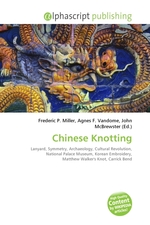Chinese Knotting
Frederic P. Miller, Agnes F. Vandome, John McBrewster
бумажная книга
High Quality Content by WIKIPEDIA articles! Chinese knotting (pinyin: Zhongguo jie) is a decorative handicraft art that began as a form of Chinese folk art in the Tang and Song Dynasty (960-1279 AD) in China. It was later popularized in the Ming). The art is also referred to as Chinese traditional decorative knots. In other cultures, it is known as "Decorative knots". Chinese knots are usually lanyard type arrangements where 2 cords enter from the top of the knot and 2 cords leave from the bottom. The knots are usually double-layered and symmetrical. Archaeological studies indicate that the art of tying knots dates back to prehistoric times. Recent discoveries include 100,000-year old bone needles used for sewing and bodkins, which were used to untie knots. However, due to the delicate nature of the medium, few examples of prehistoric Chinese knotting exist today. Some of the earliest evidence of knotting have been preserved on bronze vessels of the Warring States period (481–221 BCE), Buddhist carvings of the Northern Dynasties period (317–581) and on silk paintings during the Western Han period (206 BCE–CE6).
Данное издание не является оригинальным. Книга печатается по технологии принт-он-деманд после получения заказа.


